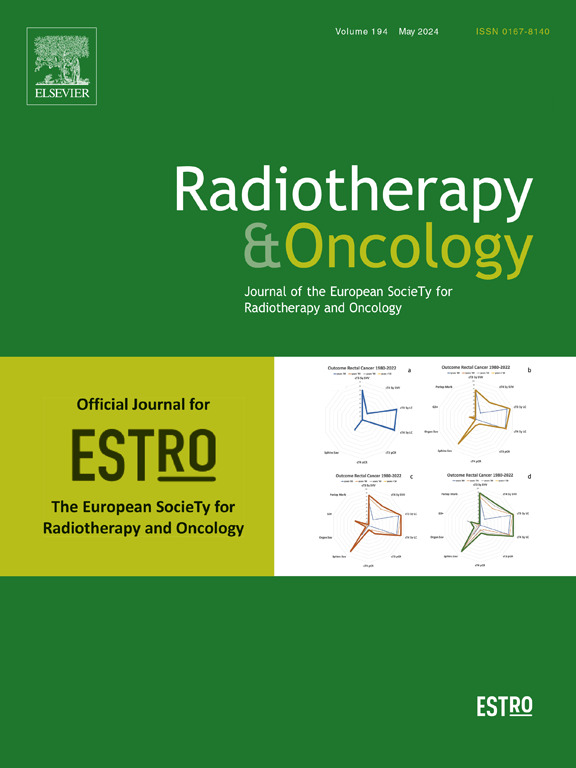DAHANCA19: A randomized phase III study of primary curative (chemo)-radiotherapy and the EGFR-inhibitor zalutumumab for squamous cell carcinoma of the head and neck
IF 4.9
1区 医学
Q1 ONCOLOGY
引用次数: 0
Abstract
Background and purpose
Antibodies against the Epidermal Growth Factor receptor is suggested to decrease tumour failure and increase survival rates of patients (pts) with Head and Neck Squamous Cell Carcinomas (HNSCC) when combined with radiotherapy. This study aimed to evaluate if concurrent treatment with the EGFR inhibitor zalutumumab during (chemo-)radiotherapy improved outcome in pts with HNSCC.
Materials and methods
Overall, 608 eligible pts with biopsy-verified HNSCC of the oral cavity, pharynx and larynx were accrued November 2007 to June 2012. Pts were randomized to a control-arm of primary accelerated radiotherapy predominantly 66–68 Gy, 2 Gy/fraction, 6fx/week and concomitant daily hypoxic radiosensitisation with nimorazole. St. III-IV carcinomas received weekly cisplatin 40 mg/m2 in addition to nimorazole. The zalutumumab-arm was identical to the control-arm plus zalutumumab 8 mg/kg. First dose was given the week before start of treatment and continued weekly during radiotherapy. Analyses were performed as intention-to-treat. Primary endpoint was loco-regional failure. Secondary endpoints were disease-specific survival and overall survival.
Results
In total, 307 pts were in the control-arm and 301 in the zalutumumab-arm. Median follow-up was 59 months. Patient and tumour parameters were well balanced. The 5-year loco-regional failure rate was 24 % in the zalutumumab-arm and 18 % in the control-arm; Hazard Ratio (HR) 1.16 (95 % CI 0.84–1.59); disease-specific survival; HR 1.04 (95 % CI 0.73–1.50) and overall survival; HR 1.21, (0.91–1.61). Effect of zalutumumab was not influenced by HPV/p16 status.
Conclusion
Addition of concomitant zalutumumab to primary (chemo-)radiotherapy and concomitant nimorazole for HNSCC did not increase loco-regional control nor disease-specific or overall survival.
dahana19:一项针对头颈部鳞状细胞癌的初始治疗(化疗)放疗和egfr抑制剂zalutumumab的随机III期研究
背景与目的:研究表明,在头颈部鳞状细胞癌(HNSCC)联合放疗时,抗表皮生长因子受体抗体可降低肿瘤衰竭,提高患者生存率。本研究旨在评估化疗期间同时使用EGFR抑制剂zalutumumab是否能改善HNSCC患者的预后。材料和方法2007年11月至2012年6月共收集了608例口腔、咽、喉活检证实的HNSCC患者。患者被随机分配到初始加速放疗的对照组,主要是66-68 Gy, 2 Gy/次,6fx/周,同时每天使用尼莫唑进行低氧放射增敏。St. III-IV癌患者除尼莫唑外,每周给予顺铂40mg /m2。zalutumumab组与对照组加zalutumumab 8 mg/kg相同。治疗开始前一周给予第一剂,放疗期间每周继续给予。分析按意向治疗进行。主要终点为局部-区域衰竭。次要终点是疾病特异性生存期和总生存期。结果对照组307例,zalutumumab组301例。中位随访时间为59个月。患者和肿瘤参数平衡良好。zalutumumab组的5年局部区域失败率为24%,对照组为18%;风险比(HR) 1.16 (95% CI 0.84-1.59);针对疾病的生存而生存;HR 1.04 (95% CI 0.73-1.50)和总生存率;Hr 1.21,(0.91-1.61)。zalutumumab的效果不受HPV/p16状态的影响。结论在原发性(化疗)放疗中联合zalutumumab和联合尼莫唑治疗HNSCC并没有增加局部区域控制,也没有增加疾病特异性或总生存期。
本文章由计算机程序翻译,如有差异,请以英文原文为准。
求助全文
约1分钟内获得全文
求助全文
来源期刊

Radiotherapy and Oncology
医学-核医学
CiteScore
10.30
自引率
10.50%
发文量
2445
审稿时长
45 days
期刊介绍:
Radiotherapy and Oncology publishes papers describing original research as well as review articles. It covers areas of interest relating to radiation oncology. This includes: clinical radiotherapy, combined modality treatment, translational studies, epidemiological outcomes, imaging, dosimetry, and radiation therapy planning, experimental work in radiobiology, chemobiology, hyperthermia and tumour biology, as well as data science in radiation oncology and physics aspects relevant to oncology.Papers on more general aspects of interest to the radiation oncologist including chemotherapy, surgery and immunology are also published.
 求助内容:
求助内容: 应助结果提醒方式:
应助结果提醒方式:


